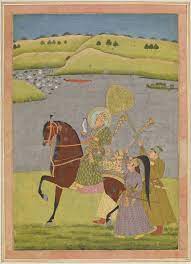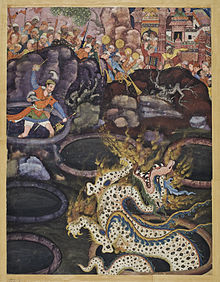
Ustad Mansur was a seventeenth-century Indian painter and naturalist who served as a Mughal court artist. During which period he excelled at depicting plants and animals. He was the earliest artist to depict the dodo in colour, apart from being the first to illustrate the Siberian crane. Towards the end of Akbar's reign, he gained the title of ustad (master) and during the reign of Mughal Emperor Jahangir his masterpieces earned him the title of Nãdir-al-’Asr. Although he was largely known for his natural history illustrations, he also portrayed people in various manuscript illustrations.

Mughal painting is a South Asian style of painting on paper confined to miniatures either as book illustrations or as single works to be kept in albums (muraqqa), originating from the territory of the Mughal Empire in the Indian subcontinent. It emerged from Persian miniature painting and developed in the court of the Mughal Empire of the 16th to 18th centuries. Battles, legendary stories, hunting scenes, wildlife, royal life, mythology, as well as other subjects have all been frequently depicted in paintings.

Rajput painting, painting of the regional Hindu courts during the Mughal era, roughly from the end of the 16th century to the middle of the 19th century. Traditionally, Rajput painting is further divided into Rajasthan and Pahari painting which flourished in two different areas "far apart from each other in terms of distance but all under the rule of Rajput chiefs, and bound together by a common culture".

Indian painting has a very long tradition and history in Indian art. The earliest Indian paintings were the rock paintings of prehistoric times, such as the petroglyphs found in places like the Bhimbetka rock shelters. Some of the Stone Age rock paintings found among the Bhimbetka rock shelters are approximately 10,000 years old. Because of the climatic conditions in the Indian subcontinent, very few early examples survive today.

The Akbarnama, is the official chronicle of the reign of Akbar, the third Mughal Emperor, commissioned by Akbar himself and written by his court historian and biographer, Abul Fazl. It was written in Persian, which was the literary language of the Mughals, and includes vivid and detailed descriptions of his life and times. It followed the Baburnama, the more personal memoir by his grandfather, Babur, founder of the dynasty. It was produced in the form of lavishly illustrated manuscripts.

Abdul Qadir Badayuni (1540–1615) was an Indian writer, historian, translator and religious leader who served as the Grand Mufti of India. He lived in the Mughal Empire. He translated into Persian the Hindu works, the Ramayana and the Mahabharata (Razmnama).

Tutinama, literal meaning "Tales of a Parrot", is a 14th-century series of 52 stories in Persian. The work remains well-known largely because of a number of lavishly illustrated manuscripts, especially a version containing 250 miniature paintings commissioned by the Mughal Emperor Akbar in the 1550s. The Persian text used was edited in the 14th century from an earlier anthology ‘Seventy Tales of the Parrot’ in Sanskrit compiled under the title Śukasaptati dated to the 12th century. In India, parrots are popular as storytellers in works of fiction.

Farrukh Beg, also known as Farrukh Husayn, was a Persian miniature painter, who spent a bulk of his career in Safavid Iran and Mughal India, praised by Mughal Emperor Jahangir as "unrivaled in the age."

'Abd al-Ṣamad or Khwaja 'Abd-us-Ṣamad was a 16th century painter of Persian miniatures who moved to India and became one of the founding masters of the Mughal miniature tradition, and later the holder of a number of senior administrative roles. 'Abd's career under the Mughals, from about 1550 to 1595, is relatively well documented, and a number of paintings are authorised to him from this period. From about 1572 he headed the imperial workshop of the Emperor Akbar and "it was under his guidance that Mughal style came to maturity". It has recently been contended by a leading specialist, Barbara Brend, that Samad is the same person as Mirza Ali, a Persian artist whose documented career seems to end at the same time as Abd al-Samad appears working for the Mughals.

Company style, also known as Company painting is a term for a hybrid Indo-European style of paintings made in British India by Indian artists, many of whom worked for European patrons in the East India Company or other foreign Companies in the 18th and 19th centuries. The style blended traditional elements from Rajput and Mughal painting with a more Western treatment of perspective, volume and recession. Most paintings were small, reflecting the Indian miniature tradition, but the natural history paintings of plants and birds were usually life size.
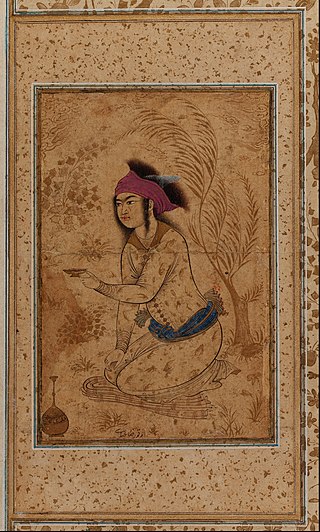
A Muraqqa is an album in book form containing Islamic miniature paintings and specimens of Islamic calligraphy, normally from several different sources, and perhaps other matter. The album was popular among collectors in the Islamic world, and by the later 16th century became the predominant format for miniature painting in the Persian Safavid, Mughal and Ottoman empires, greatly affecting the direction taken by the painting traditions of the Persian miniature, Ottoman miniature and Mughal miniature. The album largely replaced the full-scale illustrated manuscript of classics of Persian poetry, which had been the typical vehicle for the finest miniature painters up to that time. The great cost and delay of commissioning a top-quality example of such a work essentially restricted them to the ruler and a handful of other great figures, who usually had to maintain a whole workshop of calligraphers, artists and other craftsmen, with a librarian to manage the whole process.

Basāwan, or Basāvan, was an Indian miniature painter in the Mughal style. He was known by his contemporaries as a skilled colorist and keen observer of human nature, and for his use of portraiture in the illustrations of Akbarnama, Mughal Emperor, Akbar's official Biography, which is seen as an innovation in Indian art.
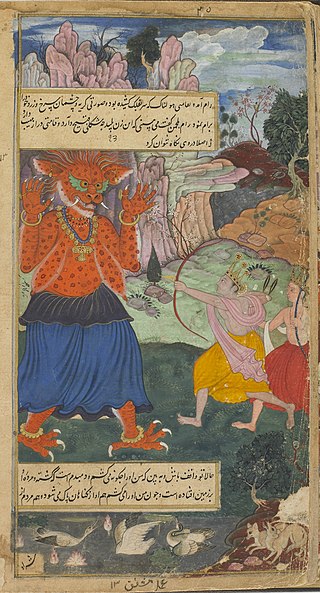
Mushfiq was a sub-imperial Mughal painter who worked in the atelier of Abd-ur-Rahim Khan-i-Khanan, commander-in-chief of the Mughal army in the late 16th/early 17th century. He contributed numerous paintings to the Ramayana and Razmnama (Mahabharata) manuscripts commissioned by the Khan-i-Khanan. Several individual paintings in his hand, some of them signed, are also known. He is not known to have worked at Akbar or Jahangir's imperial workshops.
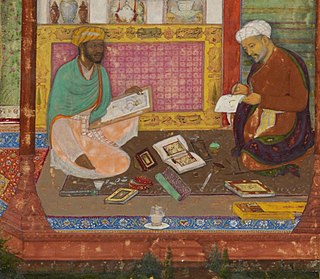
The illuminated manuscript Khamsa of Nizami British Library, Or. 12208 is a lavishly illustrated manuscript of the Khamsa or "five poems" of Nizami Ganjavi, a 12th-century Persian poet, which was created for the Mughal Emperor Akbar in the early 1590s by a number of artists and a single scribe working at the Mughal court, very probably in Akbar's new capital of Lahore in North India, now in Pakistan. Apart from the fine calligraphy of the Persian text, the manuscript is celebrated for over forty Mughal miniatures of the highest quality throughout the text; five of these are detached from the main manuscript and are in the Walters Art Museum, Baltimore as Walters Art Museum MS W.613. The manuscript has been described as "one of the finest examples of the Indo-Muslim arts of the book", and "one of the most perfect of the de luxe type of manuscripts made for Akbar".

Prince Ibrahim Mirza, Solṭān Ebrāhīm Mīrzā, in full Abu'l Fat'h Sultan Ibrahim Mirza was a Persian prince of the Safavid dynasty, who was a favourite of his uncle and father-in-law Shah Tahmasp I, but who was executed by Tahmasp's successor, the Shah Ismail II. Ibrahim is now mainly remembered as a patron of the arts, especially the Persian miniature. Although most of his library and art collection was apparently destroyed by his wife after his murder, surviving works commissioned by him include the manuscript of the Haft Awrang of the poet Jami which is now in the Freer Gallery of Art in Washington D.C.

Mir Sayyid Ali was a Persian miniature painter who was a leading artist of Persian miniatures before working under the Mughal dynasty in India, where he became one of the artists responsible for developing the style of Mughal painting, under Emperor Akbar.

The Razmnāma is a Persian translation of the Sanskrit epic Mahabharata, commissioned by the Mughal Emperor Akbar. In 1574, Akbar started a Maktab Khana or "House of Translation" in his new capital at Fatehpur Sikri. He assigned a group to translate the Sanskrit books Rajatarangini, Ramayana and Mahabharata into the Persian language, the literary language of the Mughal court.

Muhammad Daulat was a leading artist in Mughal painting, active on imperial commissions between about 1595 and 1635–1640, during the reigns of Akbar, Jahangir, and Shah Jahan. He began his career painting large narrative scenes, then specialized in portraits, but later in his career seems to have specialized in highly ornate borders to miniatures.
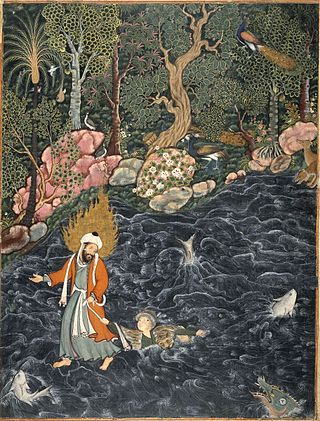
The Akbar Hamzanama is an enormous illustrated manuscript, now fragmentary, of the Persian epic Hamzanama commissioned by the Mughal emperor Akbar around 1562.

The Muraqqaʿ-e Gulshan or Moraqqaʿ-e Golshan is an eclectic album (muraqqa) of miniature paintings, drawings, calligraphy and engravings by Indo-Persian, Deccani, Turkish and European artists.

